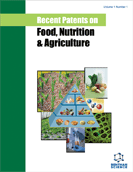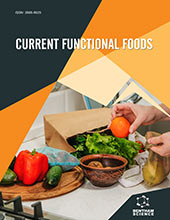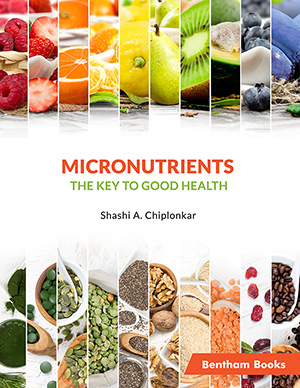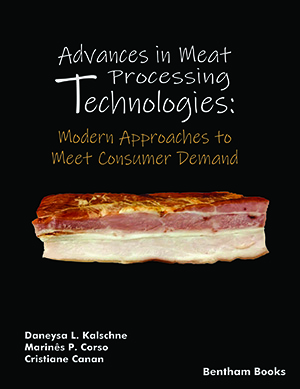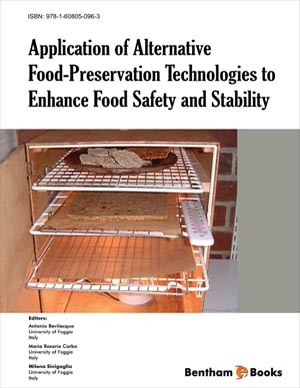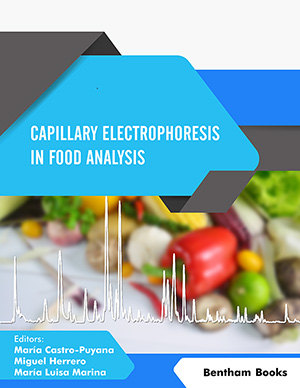Surfactin Biosynthesis and its Potential Applications in Agriculture and Food System
Page: 1-47 (47)
Author: Xiaoyu Chen, Huawei Liu and Zhaoxin Lu*
DOI: 10.2174/9789815256239124010004
PDF Price: $30
Abstract
Surfactin is a biosurfactant of the lipopeptide-type that has excellent
physicochemical properties and biological activity. However, surfactin’s high cost and
low productivity of the wild strains restrict its large-scale manufacturing and
application. Hence, numerous engineered bacteria have been utilized to boost surfactin
biosynthesis. The current review includes information on the structure,
physicochemical properties, and antibacterial mechanism of surfactin. This article also
summarizes the regulatory network of surfactin biosynthesis, the molecular
modification strategies, and the major function of surfactin, as well as its applications
in agriculture, livestock, aquaculture and the food field. Finally, future prospects for
surfactin research are discussed.
Bacillomycin Production and Its Applications in Controlling Fungi and Mycotoxin in Agriculture and Food Systems
Page: 48-70 (23)
Author: Jing Sun and Yingjian Lu*
DOI: 10.2174/9789815256239124010005
PDF Price: $30
Abstract
Fungi and mycotoxin contamination is one of the major concerns in
agriculture as well as the food system, therefore, searching for environmentally friendly
and efficient biogenic fungicides has become the path to ensure food safety.
Bacillomycin is a new type of cyclic lipopeptide biogenic fungicide secreted by
Bacillus sp. It not only has a strong antifungal function but also has the characteristics
of green safety, high stability, and drug resistance. This chapter describes the structural
types, biosynthesis and regulation, and culture optimization of bacillomycin in detail
and introduces its applications in the protection of plant diseases and green
preservation of fruits, vegetables, aquatic products, and cereal products.
Fengycin Production and Its Applications in Plant Growth and Postharvest Quality
Page: 71-119 (49)
Author: Xiaomei Bie*
DOI: 10.2174/9789815256239124010006
PDF Price: $30
Abstract
Fengycin is a cyclic lipopeptide produced mainly by the Bacillus genus,
which is structurally composed of a β-hydroxy fatty acid and 10 amino acids. The
biosynthesis of fengycin is catalyzed by large non-ribosomal peptide synthetases.
Fengycin is an amphiphilic molecule with strong surface activity and displays strong
antimicrobial activity. In this chapter, the molecular structure and biological properties
of fengycin, and the function and catalyzing mechanism of fengycin multienzyme were
summarized. Multiple antimicrobial mechanisms of fengycin and the strategies for
increasing the production of fengycin were introduced. Fengycin has the advantages of
low toxicity, biodegradation and high stability. Its applications, including biological
control of plant pathogens, bioremediation of a contaminated environment, postharvest
disease control of fruit and vegetables, food processing and preservation, etc., were
reviewed finally.
Brevibacillus sp. and Brevibacillin: Biosynthesis, Classification, Bioactivity, and Potential Applications
Page: 120-188 (69)
Author: Fanqiang Meng and Zhaoxin Lu*
DOI: 10.2174/9789815256239124010007
PDF Price: $30
Abstract
The bacterium Brevibacillus laterosporus, which forms spores, is found in
various environments, including soil, water, plants, and food. Parasporal crystals of B.
laterosporus are well known for their insecticidal properties against a wide range of
invertebrate pests. In the chapter, the isolation and identification of various
antimicrobials produced by B. laterosporus, such as lacterosporamine (C17H35N7O4),
Basiliskamide A and Basiliskamide B, Tostadin, Gramicidin A-C, Gramididin S,
Tyrocidine A-C, laterocidin, and Loloatin A-D, and the linear lipopeptides Bogorol AE, Brevibacillin were reviewed. Furthermore, their antimicrobial mechanism,
biosynthesis, and potential applications in food and agriculture were introduced.
LAB Bacteriocin-Based Strategies for Food Preservation
Page: 189-220 (32)
Author: Xinyi Pang and Yingjian Lu*
DOI: 10.2174/9789815256239124010008
PDF Price: $30
Abstract
Bacteriocins are ribosomally-synthesized peptides or proteins with broad or
narrow-spectrum antimicrobial activity. Bacteriocins produced by lactic acid bacteria
(LAB) are considered natural preservatives with safe and green properties, and their
use in food preservation meets consumer demand. In this paper, the classification of
LAB bacteriocins and their antimicrobial mechanisms are described in detail. Its
application in the preservation of food products such as meat, dairy, seafood, fruits and
vegetables is reviewed. The application of bacteriocins in hurdle technology is also
presented, including their combination with other antimicrobial agents such as essential
oils, bacteriophages, lysozymes, chemical antimicrobial agents, as well as thermal and
non-thermal processing technology. To sum up, this review will provide insights for
researchers working with lactobacillus bacteriocins as well as for industry personnel
looking for new methods of natural and safe food preservation.
Application of ε-poly-L-lysine in Improving Food Quality and Safety
Page: 221-255 (35)
Author: Ziyuan Wang, Zichen Wang, Zhilei Tan, Jiandong Cui* and Shiru Jia*
DOI: 10.2174/9789815256239124010009
PDF Price: $30
Abstract
Each year, economic losses in the food industry due to spoilage of grain,
aquatic products and fruit are huge. People now express more concern about food
safety and nutrition, therefore, the need for green preservatives is also growing.
Epsilon-poly-L-lysine (ε-PL), a cationic polyamino acid with 25–35 L-lysine residues,
possesses broad-spectrum antimicrobial activity, biodegradable properties, resistance to
high temperature, and non-toxicity and can dissolve in water. So, it has been
extensively applied in the field of preservatives for foodstuffs, agriculture and
biomedicine. Thus, the chapter mainly focuses on the recent research on microbial
synthesis, production enhancement, and antimicrobial mechanism, as well as
improving food safety, its utilization in food packaging materials and agriculture of εPL .
Bacteriophage Control of Foodborne Pathogens in Food Production
Page: 256-282 (27)
Author: Lu Liang and Ian F. Connerton*
DOI: 10.2174/9789815256239124010010
PDF Price: $30
Abstract
The application of bacteriophages (phages) that target and kill bacteria to
safeguard foods and food production facilities has attracted attention over the last
decade. As phages are often already present in foods and food production settings, their
specificity and antimicrobial activity against foodborne bacterial pathogens can be
harnessed to affect biocontrol/bio-sanitization with minimal risk to the product or the
consumer. Efficacy studies on foodborne bacterial pathogens have established the
utility of the approach, and these, coupled with the inherent safety of phages, have led
to regulatory approvals and the marketing of phage products for food safety. Here, we
review the supporting research that demonstrates the effects of phage on foods and
food contact surfaces with specific reference to the challenges of controlling bacteria
that can resist conventional cleaning processes either due to adaption and/or refuge in
microbial biofilms.
Plant-Based Antimicrobials-Innovative Natural Food Preservatives
Page: 283-352 (70)
Author: Wenqing Xu*
DOI: 10.2174/9789815256239124010011
PDF Price: $30
Abstract
Plant-based antimicrobials have been intensively studied in response to
consumers’ need to reduce the use of synthetic chemical antimicrobials, as well as the
global antibiotic resistance crisis. Bioactive compounds extracted from plants exert
potential antimicrobial activities. In this chapter, recent research on their antimicrobial
activities against foodborne pathogens in planktonic or biofilm state, antimicrobial
mechanisms, their applications and limitations in food were reviewed. Additionally, the
delivery methods for plant-based antimicrobials, including multi-hurdle,
nanoemulsions, and edible coating/film technologies, were summarized. Lastly, the
future research needs on plant-based antimicrobials were discussed.
Subject Index
Page: 353-358 (6)
Author: Zhaoxin Lu and Yingjian Lu
DOI: 10.2174/9789815256239124010012
Introduction
Bio-Based Antimicrobial Agents to Improve Agricultural and Food Safety provides a comprehensive overview of the latest advancements in bio-based antimicrobial agents used to enhance food safety and agricultural production. This book highlights natural alternatives to chemical preservatives, focusing on surfactin, bacillomycin, fengycin, bacteriocins, and plant-based antimicrobials. It explores their applications in controlling microbial contamination, improving crop health, and extending food shelf life. Key topics include biopreservation techniques, biological control of pathogens, and sustainable agricultural practices. With contributions from experts worldwide, this book is an essential resource for researchers, biotechnologists, microbiologists, food scientists, and industry professionals aiming to understand modern bio-safe methods for food preservation and crop protection.



